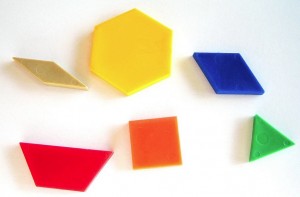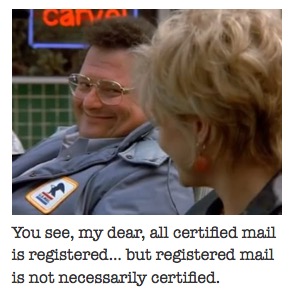I’m always amused when teachers try to censor correct children’s language, especially when it comes to mathematics. I remember observing a kindergarten teacher working with a child on the names of the pattern block shapes, and the child correctly identifying the orange square and the green triangle without hesitation. When the blue “rhombus” showed up, things took a turn for the worse. The child looked it over and said, “oh, that’s a diamond!” and the teacher said, “no, it’s a rrrr…….” trying to prompt the young man to say the word “rhombus,” which I’m probably going to bet he never heard in his life. The child looked confused and said, “riamond?” The teacher shook her head, and explained, “no, it’s a rhombus. Can you say that?”

How many rhombi do you see in this picture?
I know that as teachers we like to fulfill our missions by trying to find that “teachable moment” when we can introduce a new word or idea to our students, but as my college art professor, the great Walter Feldman once said, “it’s not what you show, but also what you don’t show that matters.” In this case, the teacher most likely created a misunderstanding that will stay with the child for many years to come.
The word “rhombus” is a very complicated concept (and yes, nouns can be concepts) and for many years I’ve asked teachers not to introduce this particular term until 4th grade. This may seem like “dumbing down” the curriculum by not introducing a “fancy” word early and often, but in reality, it makes great sense, especially when you consider the development of logical thinking in children.
A rhombus is an example of a shape that has a particular set of characteristics that is not exclusive. A rhombus is a simple closed curve, a polygon, a quadrilateral and a parallelogram. It can be a rectangle and it can be a square. When it is a square, it becomes a type of rectangle, but when it isn’t a square, it remains a “rhombus,” which is not to be confused with a “rhomboid,” which is a parallelogram where the adjacent sides are not equal and where the angles are not right angles.

What we have here is a failure to communicate…
If this is confusing you, then imagine what it must be to a child. Basically, our language for geometric shapes is lacking in that we don’t have exact words for the shapes that include some properties but lack others. For example, a parallelogram describes all quadrilaterals that have 4 sides, where the opposite sides are congruent and parallel. We then have a word for the parallelogram that has 4 right angles: a rectangle. What we don’t have is a name for the parallelogram that does not have 4 right angles. We call it a “parallelogram,” but if we do, then it would exclude the “rectangle.” The best we can do is explain that a “rectangle” is simply a special case of the parallelogram, and go on to admit that there is no word for the parallelogram that is not a rectangle.
Things become considerably more difficult when we discuss the rhombus. A rhombus is a type of parallelogram, for it also has 2 sets of parallel sides which are also congruent. However, a rhombus is another special case of a parallelogram, for it occurs when all 4 sides are equal. Simple, but not so simple….
This is where that nasty shape, “the square,” shows up at the intersection of two different ways to classify shapes: it is linked to the rhombus by having all 4 sides equal, but it is also linked to the rectangle by having 4 right angles. This means it lies at the intersection of two different schemes for classifying quadrilaterals: one that restricts it by the angles, and another that restricts it by the length of its sides. ARGHHHHH!

An example of a statement and its converse.
All of which brings us to these problems of logical thinking having to do with syllogism and bi-conditional logic. One statement would read like this: “all rhombi are parallelograms,” which is true. Its converse, “all parallelograms are rhombi” is not true, for obvious reasons – a parallelogram could also be a rectangle (which could also be a square) or it could be just a plain old parallelogram without right angles, which we call…. a parallelogram. ARGHHHHHH!
Connecting rhombi to squares creates this statement: “all squares are rhombi, but not all rhombi are squares.” And what do we call the rhombus that is not a square? “A rhombus!” ARGHHHHHH!
Suffice it to say, all this is very confusing to adults as well as children (I once spent an hour with a supervisor explaining explaining the statement about rhombi and squares, including why we pluralize “rhombus” to “rhombi” instead of the must easier to remember “rhombuses.”) All of which is to say is this: what’s the hurry with introducing the word “rhombus” to children? Why not let them call it a diamond, which is an actual mathematical term? The reasoning behind what makes a rhombus a rhombus is very complicated and highly specific and completely inappropriate for a young child. Think of how much harder it will be if the only rhombus a child has encountered is the blue pattern block? Sure, you can give a long-winded explanation of how the English geometric vocabulary is very complicated and illogical, but why bother? At this age, shouldn’t children be solving puzzles and moving shapes around, instead of learning complicated and irrelevant vocabulary?
This post has been brought to you by my authoritative guide on teaching developmental geometry using the educational work of Pierre van Hiele and Diane Geldof.
 This 60 page booklet incorporates the theories of Pierre van Hiele and Dina van HIele-Geldorf, better known as the van Hiele Theory, to teach developmental geometry in elementary and middle school. The van Hiele’s were pioneers in the understanding that children go through different levels of cognitive development in their understanding of geometric concepts, and that these levels changed with the age and education of the child. Through their work, we’ve come to understand what kinds of thinking can be developed by children as they grow and develop.
This 60 page booklet incorporates the theories of Pierre van Hiele and Dina van HIele-Geldorf, better known as the van Hiele Theory, to teach developmental geometry in elementary and middle school. The van Hiele’s were pioneers in the understanding that children go through different levels of cognitive development in their understanding of geometric concepts, and that these levels changed with the age and education of the child. Through their work, we’ve come to understand what kinds of thinking can be developed by children as they grow and develop.
This booklet is based on the idea of using a set of 7 tiles, which I call “van Hiele Tiles,” based on an article published in the journal Teaching Children Mathematics. In the article, Pierre van Hiele describes a method of using “play” to develop children’s thinking about geometry. The booklet describes the Van Hiele Model in details, and then has explicit, self contained activities at each level of thinking.
These activities require the use of a set of 7 tiles, which can be printed and cut out using the template in the book. These tiles are much more versatile than tangrams or pattern blocks, as they contain a much more diverse collection of shapes, including a right scalene triangles, equilateral triangle, isosceles obtuse triangle, isosceles trapezoid, concave trapezoid and oblong rectangle, which can be configured into many different shapes (including larger versions of one another.) You can learn more about these shapes at www.goodnitebob.com .
